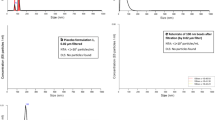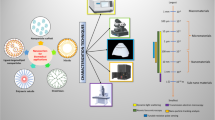Abstract
Purpose
Characterizing submicron protein particles (approximately 0.1–1μm) is challenging due to a limited number of suitable instruments capable of monitoring a relatively large continuum of particle size and concentration. In this work, we report for the first time the characterization of submicron protein particles using the high size resolution technique of resistive pulse sensing (RPS).
Methods
Resistive pulse sensing, dynamic light scattering and size-exclusion chromatography with in-line multi-angle light scattering (SEC-MALS) are performed on protein and placebo formulations, polystyrene size standards, placebo formulations spiked with silicone oil, and protein formulations stressed via freeze-thaw cycling, thermal incubation, and acid treatment.
Results
A method is developed for monitoring submicron protein particles using RPS. The suitable particle concentration range for RPS is found to be approximately 4 × 107-1 × 1011 particles/mL using polystyrene size standards. Particle size distributions by RPS are consistent with hydrodynamic diameter distributions from batch DLS and to radius of gyration profiles from SEC-MALS. RPS particle size distributions provide an estimate of particle counts and better size resolution compared to light scattering.
Conclusion
RPS is applicable for characterizing submicron particles in protein formulations with a high degree of size polydispersity. Data on submicron particle distributions provide insights into particles formation under different stresses encountered during biologics drug development.




Similar content being viewed by others
Abbreviations
- AF4:
-
Asymmetrical flow field fractionation
- AUC:
-
Analytical ultracentrifugation
- DLS:
-
Dynamic light scattering
- LO:
-
Light obscuration
- mAb:
-
Monoclonal antibody
- MFI:
-
Micro flow imaging
- NTA:
-
Nanoparticle tracking analysis
- PBS:
-
Phosphate buffer saline
- PS-80:
-
Polysorbate-80
- RMM:
-
Resonant mass measurement
- RPS:
-
Resistive pulse sensing
- SAXS:
-
Small angle x-ray scattering
- SEC:
-
Size exclusion chromatography
- SEC-MALS:
-
Size exclusion chromatography with multi-angle light scattering
References
Das TK. Protein particulate detection issues in biotherapeutics development--current status. AAPS PharmSciTech. 2012;13(2):732–46.
Rosenberg AS. Effects of protein aggregates: an immunologic perspective. AAPS J. 2006;8(3):E501–7.
Cheung CS, Anderson KW, Patel PM, Cade KL, Phinney KW, Turko IV. A new approach to quantification of mAb aggregates using peptide affinity probes. Sci Rep. 2017;7:42497.
Arvinte T, Palais C, Green-Trexler E, Gregory S, Mach H, Narasimhan C, et al. Aggregation of biopharmaceuticals in human plasma and human serum: implications for drug research and development. MAbs. 2013;5(3):491–500.
Boll B, Bessa J, Folzer E, Rios Quiroz A, Schmidt R, Bulau P, Finkler C, Mahler HC, Huwyler J, Iglesias A, Koulov AV. Extensive chemical modifications in the primary protein structure of IgG1 subvisible particles are necessary for breaking immune tolerance. Mol Pharm. 2017;14(4):1292–9.
Joubert MK, Hokom M, Eakin C, Zhou L, Deshpande M, Baker MP, et al. Highly aggregated antibody therapeutics can enhance the in vitro innate and late-stage T-cell immune responses. J Biol Chem. 2012;287(30):25266–79.
Rombach-Riegraf V, Karle AC, Wolf B, Sorde L, Koepke S, Gottlieb S, et al. Aggregation of human recombinant monoclonal antibodies influences the capacity of dendritic cells to stimulate adaptive T-cell responses in vitro. PLoS One. 2014;9(1):e86322.
Ahmadi M, Bryson CJ, Cloake EA, Welch K, Filipe V, Romeijn S, Hawe A, Jiskoot W, Baker MP, Fogg MH. Small amounts of sub-visible aggregates enhance the immunogenic potential of monoclonal antibody therapeutics. Pharm Res. 2015;32:1383–94.
Pharmacopeia US. USP: <788> Particular Matter in Injections. Revision Bulletin. 2011.
Ripple DC, Hu Z. Correcting the Relative Bias of Light Obscuration and Flow Imaging Particle Counters. Pharm Res. 2016;33(3):653–72.
Joubert MK, Luo Q, Nashed-Samuel Y, Wypych J, Narhi LO. Classification and characterization of therapeutic antibody aggregates. J Biol Chem. 2011;286(28):25118–33.
Singh SK, Afonina N, Awwad M, Bechtold-Peters K, Blue JT, Chou D, et al. An industry perspective on the monitoring of subvisible particles as a quality attribute for protein therapeutics. J Pharm Sci. 2010;99(8):3302–21.
Carpenter JF, Randolph TW, Jiskoot W, Crommelin DJ, Middaugh CR, Winter G. Potential inaccurate quantitation and sizing of protein aggregates by size exclusion chromatography: essential need to use orthogonal methods to assure the quality of therapeutic protein products. J Pharm Sci. 2010;99(5):2200–8.
Bria CR, Jones J, Charlesworth A, Ratanathanawongs Williams SK. Probing Submicron Aggregation Kinetics of an IgG Protein by Asymmetrical Flow Field-Flow Fractionation. J Pharm Sci. 2016;105(1):31–9.
Hawe A, Romeijn S, Filipe V, Jiskoot W. Asymmetrical flow field-flow fractionation method for the analysis of submicron protein aggregates. J Pharm Sci. 2012;101(11):4129–39.
Wagner M, Holzschuh S, Traeger A, Fahr A, Schubert US. Asymmetric flow field-flow fractionation in the field of nanomedicine. Anal Chem. 2014;86(11):5201–10.
Gabrielson JP, Brader ML, Pekar AH, Mathis KB, Winter G, Carpenter JF, et al. Quantitation of aggregate levels in a recombinant humanized monoclonal antibody formulation by size-exclusion chromatography, asymmetrical flow field flow fractionation, and sedimentation velocity. J Pharm Sci. 2007;96(2):268–79.
Weinbuch D, Cheung JK, Ketelaars J, Filipe V, Hawe A, den Engelsman J, et al. Nanoparticulate Impurities in Pharmaceutical-Grade Sugars and their Interference with Light Scattering-Based Analysis of Protein Formulations. Pharm Res. 2015;32:2419–27.
Tian X, Nejadnik MR, Baunsgaard D, Henriksen A, Rischel C, Jiskoot W. A Comprehensive Evaluation of Nanoparticle Tracking Analysis (NanoSight) for Characterization of Proteinaceous Submicron Particles. J Pharm Sci. 2016;105(11):3366–75.
Filipe V, Hawe A, Jiskoot W. Critical evaluation of Nanoparticle Tracking Analysis (NTA) by NanoSight for the measurement of nanoparticles and protein aggregates. Pharm Res. 2010;27(5):796–810.
Zhou C, Krueger AB, Barnard JG, Qi W, Carpenter JF. Characterization of Nanoparticle Tracking Analysis for Quantification and Sizing of Submicron Particles of Therapeutic Proteins. J Pharm Sci. 2015;104(8):2441–50.
Bai K, Barnett GV, Kar SR, Das TK. Interference from proteins and surfactants on particle size distributions measured by nanoparticle tracking analysis (NTA). Pharm Res. 2017;34:800–8.
Rios Quiroz A, Finkler C, Huwyler J, Mahler HC, Schmidt R, Koulov AV. Factors Governing the Accuracy of Subvisible Particle Counting Methods. J Pharm Sci. 2016;105(7):2042–52.
Rios Quiroz A, Lamerz J, Da Cunha T, Boillon A, Adler M, Finkler C, et al. Factors Governing the Precision of Subvisible Particle Measurement Methods - A Case Study with a Low-Concentration Therapeutic Protein Product in a Prefilled Syringe. Pharm Res. 2016;33(2):450–61.
Yang L, Yamamoto T. Quantification of Virus Particles Using Nanopore-Based Resistive-Pulse Sensing Techniques. Front Microbiol. 2016;7:1500.
Maas SL, Broekman ML, de Vrij J. Tunable Resistive Pulse Sensing for the Characterization of Extracellular Vesicles. Methods Mol Biol. 2017;1545:21–33.
Fraikin JL, Teesalu T, McKenney CM, Ruoslahti E, Cleland AN. A high-throughput label-free nanoparticle analyser. Nat Nanotechnol. 2011;6(5):308–13.
Berne, BJ, Pecora, R. Dynamic light scattering: with applications to chemistry, biology, and physics. Mineola: Dover Publications; 2000.
Amin S, Barnett GV, Pathak JA, Roberts CJ, Sarangapani PS. Protein aggregation, particle formation, characterization & rheology. Curr Opin Colloid Interface Sci. 2014;19(5):438–49.
Gupta A, Eral HB, Hatton TA, Doyle PS. Controlling and predicting droplet size of nanoemulsions: scaling relations with experimental validation. Soft Matter. 2016;12(5):1452–8.
Li Y, Roberts CJ. Lumry-Eyring nucleated-polymerization model of protein aggregation kinetics. 2. Competing growth via condensation and chain polymerization. J Phys Chem B. 2009;113(19):7020–32.
Ejima D, Tsumoto K, Fukada H, Yumioka R, Nagase K, Arakawa T, et al. Effects of acid exposure on the conformation, stability, and aggregation of monoclonal antibodies. Proteins. 2007;66(4):954–62.
Hari SB, Lau H, Razinkov VI, Chen S, Latypov RF. Acid-induced aggregation of human monoclonal IgG1 and IgG2: molecular mechanism and the effect of solution composition. Biochemistry. 2010;49(43):9328–38.
Hawe A, Kasper JC, Friess W, Jiskoot W. Structural properties of monoclonal antibody aggregates induced by freeze-thawing and thermal stress. Eur J Pharm Sci. 2009;38(2):79–87.
Author information
Authors and Affiliations
Corresponding author
Rights and permissions
About this article
Cite this article
Barnett, G.V., Perhacs, J.M., Das, T.K. et al. Submicron Protein Particle Characterization using Resistive Pulse Sensing and Conventional Light Scattering Based Approaches. Pharm Res 35, 58 (2018). https://doi.org/10.1007/s11095-017-2306-0
Received:
Accepted:
Published:
DOI: https://doi.org/10.1007/s11095-017-2306-0




